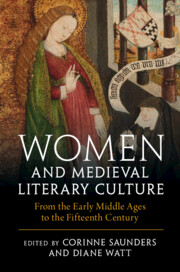Book contents
- Women and Medieval Literary Culture
- Women and Medieval Literary Culture
- Copyright page
- Contents
- Illustrations
- Contributors
- Acknowledgements
- Introduction
- I Patrons, Owners, Writers, and Readers in England and Europe
- Chapter 1 ‘Miserere, meidens’
- Chapter 2 Creating Her Own Story
- Chapter 3 Woman-to-Woman Initiatives Between English Female Religious
- II Circles and Communities in England
- III Health, Conduct, and Knowledge
- IV Genre and Gender
- V Women as Authors
- General Index
- Index of Manuscripts
- References
Chapter 3 - Woman-to-Woman Initiatives Between English Female Religious
from I - Patrons, Owners, Writers, and Readers in England and Europe
Published online by Cambridge University Press: 28 July 2023
- Women and Medieval Literary Culture
- Women and Medieval Literary Culture
- Copyright page
- Contents
- Illustrations
- Contributors
- Acknowledgements
- Introduction
- I Patrons, Owners, Writers, and Readers in England and Europe
- Chapter 1 ‘Miserere, meidens’
- Chapter 2 Creating Her Own Story
- Chapter 3 Woman-to-Woman Initiatives Between English Female Religious
- II Circles and Communities in England
- III Health, Conduct, and Knowledge
- IV Genre and Gender
- V Women as Authors
- General Index
- Index of Manuscripts
- References
Summary
This essay addresses the education of religious women, figured in terms of horizontal and vertical learning, in England at the end of the Middle Ages. It highlights connections between women rather than the more widely discussed relationships between women and their male spiritual advisors. From an examination of the texts obtained by women leaders of the late medieval womenߣs houses, including the English Bridgettine abbey of Syon, it is evident that superiors acquired works relating to the religious rule of life and other devotional texts, and aimed to enable their communities to understand their life and governance. Erler shows that such works were shared via the vertical learning of refectory and other communal readings. Alongside this, more traditional horizontal learning or hierarchical instruction also took place in womenߣs houses: nuns were expected to emulate their elders, and the elders to offer guidance, including in relation to their reading, to which the exchange of books between nuns was central practice. Finally, there is evidence of more formal convent instruction, framed in compassionate and supportive terms.
- Type
- Chapter
- Information
- Women and Medieval Literary CultureFrom the Early Middle Ages to the Fifteenth Century, pp. 65 - 80Publisher: Cambridge University PressPrint publication year: 2023



